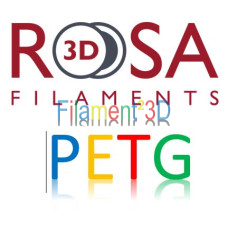PETG
PETG (polyethylene terephthalate glycol)
The PETG material is essentially the same as the known PET material from which PET bottles are made. The G in the acronym PETG stands for Glycol which is added during the manufacturing process. Glycol modifies the properties of PET so that it’s easier to print and less brittle. It is a strong and tough material, which is characterized by good thermal stability. Thanks to the small shrinkage during printing, it is suitable for printing large objects. PETG has mechanical and thermal properties better than ABS and bearing the printing properties of PLA.
PETG is more elastic than e.g. PET, but still retains the strength and layer bonding. It has an increased tendency to make small strings when printing. Therefore, it may be advisable to increase its retraction relative to e.g. PLA.
PETG is printed at 230-250 ° C. A heated plate is needed; it should be heated to 60-80 ° C.
PETG filament is hygroscopic, which means that it absorbs moisture from the surrounding air - it is therefore recommended to store the material in a bag together with silica gel to bind any. moisture. You will get a significantly nicer print, you keep your PETG dry, possibly. with a decidedly filament dryer like this.
Manufacturers
Filament PM PETG
21 Colors to choose from.PETG (polyethylene terephthalate glycol)- PETG is a universal material- fo..
81,25DKr Ex Tax: 65,00DKr
Filamentive PETG
High quality PETG 3D Printer filament 1KgRecycled content: 99.5% (2019 average of all colo..
327,50DKr Ex Tax: 262,00DKr
HDGlass (PETG)
HDglass is a high performance filament based on an unique PETG blend resulting in an amorphous, high..
261,00DKr Ex Tax: 208,80DKr
Prusament PETG
What can you expect?Prusament PETG is our own in-house made filament. The whole manufacturing proces..
268,75DKr Ex Tax: 215,00DKr
ReForm rPET
ReForm is a sustainable initiative within Formfutura to proactively contribute to making 3D printing..
127,50DKr Ex Tax: 102,00DKr
RePETG 1.75mm 1Kg
- PETG filament made from recycled material. ♻- The color is going to be a bit different every..
125,00DKr Ex Tax: 100,00DKr
ROSA3D PETG
Filament PET-G Standard from ROSA3D is characterized by the ease of printing comparable to PLA. Dedi..
120,50DKr Ex Tax: 96,40DKr







